Every NHL general manager wants to succeed. They want to build a roster that competes night in and night out. They want to win and raise the Stanley Cup.
To that goal, they make trades to improve their respective squads. On most occasions, trades in the NHL work out well – both teams improve following the arrival of a new player(s) or assets. Weaknesses are addressed. Needs are fulfilled.
Sign up for our NHL History Substack newsletter
But there are times when trades are completely lopsided, leaving one team with prized assets and the other with nothing but remorse. Good players can flourish, becoming superstars while others flounder. Often the outcome of a trade isn’t known for a season or two.
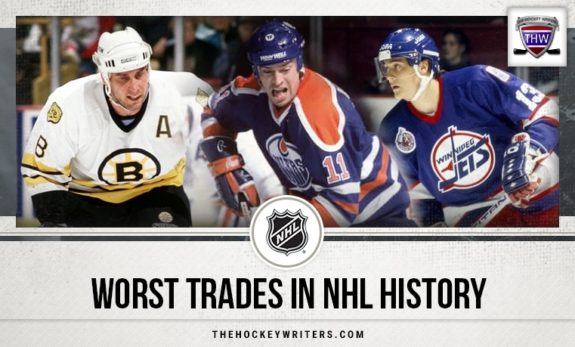
Listed below are some of the worst trades to have taken place in NHL history.
New York Rangers Trade Rick Middleton to Boston Bruins
In 1976, the New York Rangers traded Rick Middleton to the Boston Bruins for veteran Ken Hodge, straight up. Middleton, seen as a bright and rising star, had scored 46 goals in his first two seasons on Broadway, though he was known to enjoy the New York scene a bit too much.
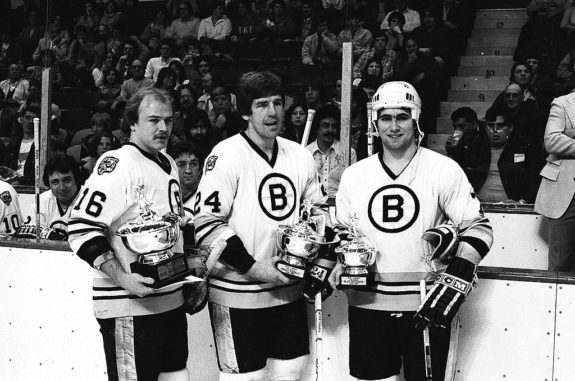
When Middleton arrived in Boston, he was coached by bombastic loudmouth Don Cherry, who wouldn’t accept nonsense behavior and such gallivanting from his players. As a result, Middleton spent more time in the gym than the party scene and developed into an explosive scorer. He scored 402 goals in 881 games in a Bruins uniform.
Meanwhile, Hodge’s career ended quickly. He scored 23 goals for the Rangers before retiring, having played only 96 games for the Blueshirts.
Montreal Canadiens Trade Patrick Roy
The Canadiens shipped Patrick Roy to the Colorado Avalanche with captain Mike Keane for Jocelyn Thibault, Martin Rucinsky and Andrei Kovalenko. The trade was a complete disaster for Montreal.
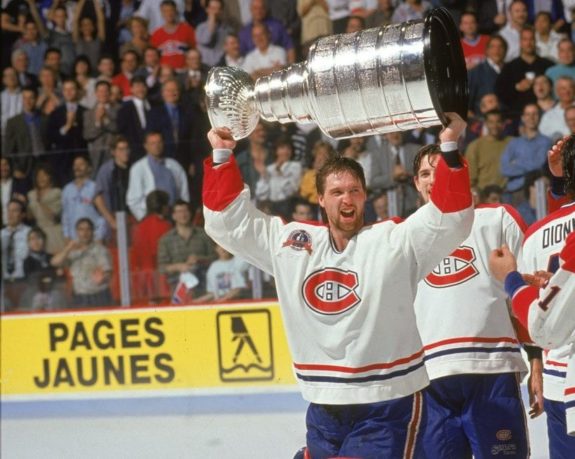
In Colorado, with Roy in net, the Avalanche became perennial Stanley Cup contenders. They won the Cup in 1996 and 2001. The Canadiens, on the other hand, went into a downward spiral and were not a competitive team for several seasons. (from ‘Canadiens’ 1993 Cup win, Part II: Patrick Roy trade capped demolition,’ Montreal Gazette, 06/04/2018)
Winnipeg Jets Trade Teemu Selanne to Anaheim Mighty Ducks
Teemu Selanne, is pure a goal scorer as the league has known, was traded with Marc Chouinard, and a fourth-round pick to the Anaheim Mighty Ducks on Feb. 6, 1996 for first-round draft picks Chad Kilger and Oleg Tverdovsky, along with a third-round pick at the 1996 NHL Entry Draft.
The deal changed Selanne’s life as well as the Ducks’ franchise.
The trade was a robbery. Selanne became the face of the franchise for many, many years, and still is to a certain extent. He’s the greatest Duck of all time.
Rangers Trade Jean Ratelle and Brad Park to Boston Bruins
After losing in the semifinal round of the playoffs to the Philadelphia Flyers in 1974 and in the first round in 1975 to the archrival New York Islanders, the Rangers felt the need to shake up their roster. In doing so, they made this list.
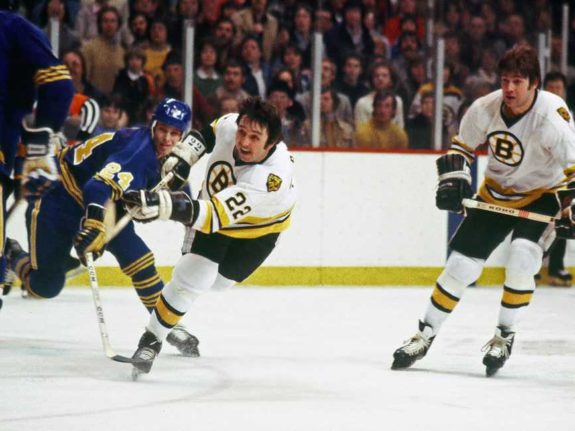
The Rangers let netminder Eddie Giacomin go on waivers to the Detroit Red Wings, then traded center Jean Ratelle and defenseman Brad Park and Joe Zanussi to the Bruins for high-scoring Phil Esposito and defenseman Carol Vadnais.
Honourable Mention: Phil Esposito Makes His Way to Boston
The move was a disaster. Ratelle and Park played out terrific careers for the Bruins. While Esposito was still nearly a point-per-game player, he never quite had the same success in New York that he did in Boston.
Vancouver Canucks Trade Cam Neely and 1st-Round Draft Choice to Boston Bruins
In his first three seasons, Cam Neely scored 51 goals, posting a minus-56 plus-minus rating for the Canucks. He had also earned over 300 penalty minutes.
The Canucks then packaged Neely and a first-round draft pick (turned out to be defenseman Glen Wesley) to the Bruins for center Barry Pederson.
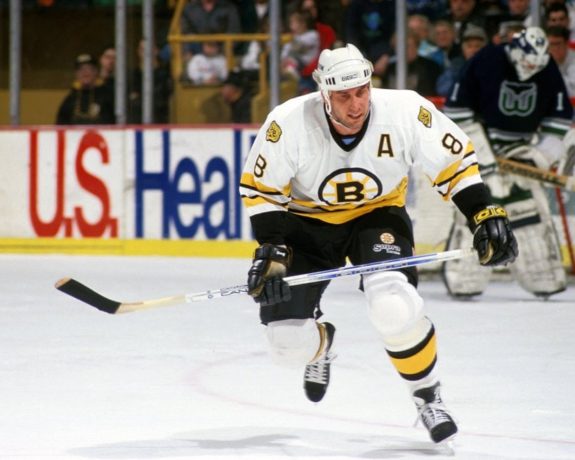
Neely played the rest of his career in Boston, playing 10 seasons and racking up 344 goals and 246 assists in 525 games. He was one of the league’s most-feared power forwards – a mix of pure strength and skill. If he didn’t beat you with his goal-scoring, he did with his fists. He hit the 50-goal mark three times and was inducted into the Hall of Fame in 2005.
Related: Boston Bruins 50-Goal Scorers
Pederson’s career after Beantown fizzled. He only hit the 20-goal mark once with the Canucks and bounced around the NHL, playing for several teams.
New York Islanders Trade Zdeno Chara to the Ottawa Senators
In June 2001, the New York Islanders made a disastrous deal.
Zdeno Chara had yet to pan out with the Islanders and was traded to the Ottawa Senators alongside Bill Muckalt and a 1st-round draft pick in exchange for Alexei Yashin.

Yashin was a highly skilled, highly sought-after player. Drafted second overall by the Senators in 1992, Yashin averaged just under a point per game during his seven seasons in Ottawa, scoring 491 points in 504 games before he was traded to New York.
Meanwhile, Chara became one of the most intimidating, highly skilled defenders to play in the NHL. Averaging around 25 minutes per game, Chara found his scoring touch with the Senators, scoring 146 points in 299 career games in Ottawa.
And who did the Senators end up drafting with the pick they received from the Islanders; star player and former captain Jason Spezza.
Meanwhile, Yashin only played five seasons with the Islanders before his contract was bought out. During his time on the island, Yashin’s play deteriorated, scoring 290 points in 346 career games. The Islanders paid Yashin $2.2 million in buyout money every season from 2007-08 through 2014-15.
Calgary Trades Brett Hull to the St. Louis Blues
In March 1988, the Calgary Flames made one of the worst trades in NHL history.
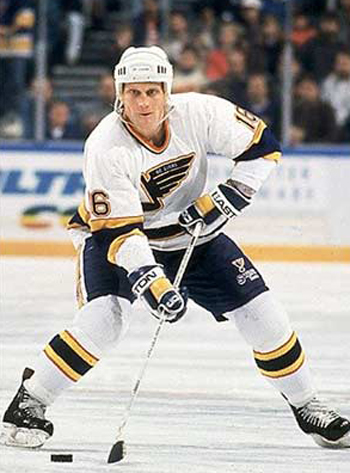
At the young age of 23, Brett Hull was in the middle of a great rookie season, having scored 50 points through his first 52 career games. It didn’t matter. The Flames traded Hull, alongside Steve Bozek in exchange for Rob Ramage and Rick Wamsley.
Of the two players the Flames received, Ramage was the most skilled. A strong defender, Ramage could also contribute offensively, yet he only played with the Flames for one full season before he was traded to the Toronto Maple Leafs. Goaltender Rick Wamsley was not a standout player either. Wamsley played parts of four seasons with the Flames as a backup before he too was traded to the Toronto Maple Leafs in a huge trade that also made this list.
In Brett Hull, the St. Louis Blues acquired one of the most dynamic goalscorers in NHL history. In his first season with the Blues, Hull scored 41 goals. He followed up this performance by posting totals of 72, 86 and 70 goals in his next three seasons in St.Louis.
All in all, Hull ended up playing in St. Louis for 11 years. In his 744 career games with the Blues, Hull scored 527 goals and 936 points.
He was inducted into the Hockey Hall of Fame in 2009.
Calgary Trades Doug Gilmour to the Toronto Maple Leafs
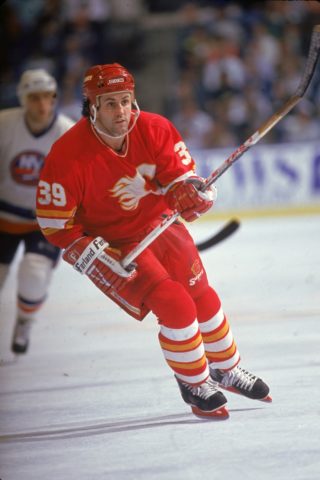
In early 1992, the Calgary Flames completed a 10-player trade with the Toronto Maple Leafs centered around Doug Gilmour.
At 28, Gilmour was not an emerging young star, but an accomplished NHL player. Having split the first nine years of his career between the Flames and the St. Louis Blues, Gilmour was highly skilled offensively, having posted point-per-game numbers in his first 650 games.
The most notable player going the other way was Gary Leeman, a 50-goal scorer with the Leafs who managed only 11 goals in 59 games with the Flames before he was sent packing to the Montreal Canadiens.
Gilmour went on to become one of the most notable leaders in Maple Leaf history. His presence in the locker room is well documented, while his on-ice abilities were also unique. Gilmour played a gritty style of hockey despite his small stature, yet was able to contribute offensively on a consistent basis. In his seven seasons with the Maple Leafs, Gilmour scored 452 points in 393 games alongside 386 penalty minutes.
He was inducted into the Hockey Hall of Fame in 2011.
Detroit Red Wings Trade Marcel Dionne to the Los Angeles Kings
Marcel Dionne’s illustrious career began with the Detriot Red Wings. In Motown, he scored 139 goals and added 227 assists for 366 points in 309 games. Very impressive by any metric.
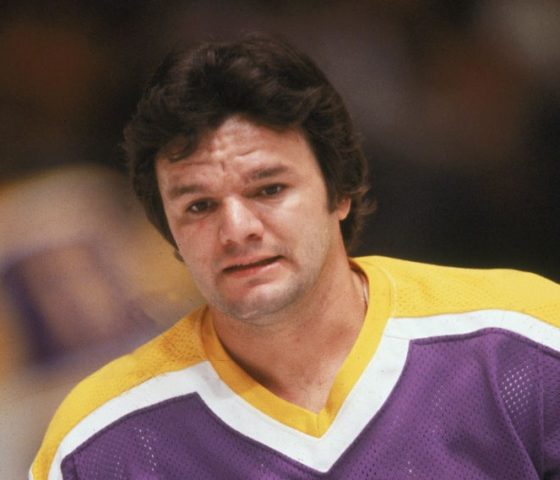
In 1975, the brilliant front office staff of the Red Wings then decided to trade Dionne to the Kings with defenseman Bart Crashley for Dan Maloney, Terry Harper and a second-round draft choice.
Related: Los Angeles Kings’ 50-Goal Scorers
Dionne went on to play 12 seasons for the Kings, putting up 1,307 points in 921 games. He had six 50-goal seasons with the Kings and holds several scoring records for the franchise. He was inducted into the Hall of Fame in 1992.
Edmonton Trades Mark Messier to the New York Rangers
In 1991, the Oilers made the second-worst trade in their franchise history, sending their heart and soul – Mark Messier – and future considerations (Jeff Beukeboom and David Shaw) to the New York Rangers in exchange for Louie DeBrusk, Steven Rice and Los Angeles Kings’ great Bernie Nicholls.
At the age of 29, Messier had already won five Stanley Cups with the Edmonton Oilers and certainly had plenty left in the tank.
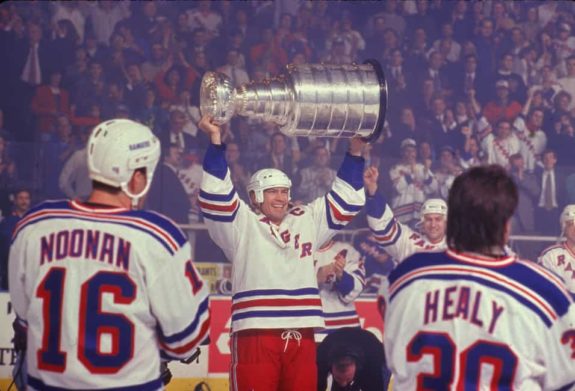
For the Oilers, the return did not match the production and leadership leaving town. DeBrusk played parts of six seasons with the Oilers, yet was never a consistent threat at either end of the ice. Rice split parts of three seasons between the Oilers and the minors, failing to establish himself as an everyday NHL player. Nicholls was the biggest name returning to the Oilers, however, he was traded to the New Jersey Devils after parts of two seasons with the Oilers.
Meanwhile, Messier poured in 107 points in his first season as a Ranger. He went on to win a sixth Stanley Cup with the Rangers in 1993-94 in which he famously guaranteed a win against the New Jersey Devils to tie the series before moving on and winning in the finals. Through 422 games in his first stint with the Rangers, Messier scored 515 points along with winning the Hart Memorial Trophy and Ted Lindsay Award.
Messier was inducted into the Hockey Hall of Fame in 2007.
Oilers Trade Wayne Gretzky to the Los Angeles Kings
In Aug. 1988, the Edmonton Oilers completed what is likely the most controversial trade in the history of the NHL. They sent Wayne Gretzky to the L.A. Kings in what turned out to be an eight-player deal.
At the age of 26, Gretzky had plenty of hockey ahead of him, yet due to rumoured financial difficulties with then Edmonton Oilers owner Peter Pocklington, the team was forced to trade the best player in NHL history.
In return, the Oilers received two players and three first-round draft picks. One of the picks was Jimmy Carson who posted a 100-point season with the Oilers, although he only played two seasons with the team. Martin Gelinas was not a spectacular player, as he only wound up playing with the Oilers for four years.
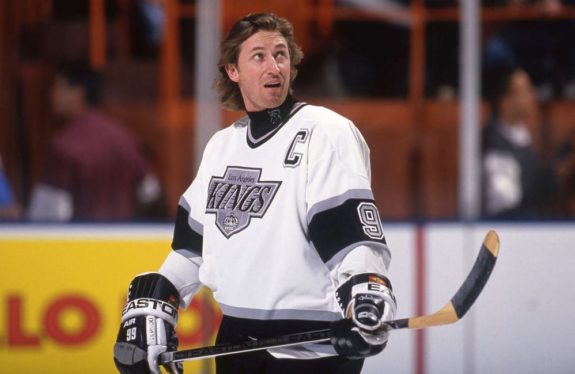
Of the three picks the Oilers received, Jason Miller played only six games while Nick Stajduahr played only two games in the NHL. Martin Rucinsky turned into a good player, however, he only played two games with the Oilers.
As many know, Gretzky moved to Los Angeles where he continued doing what he had done his entire career: dominating the NHL.
In his 539 games with the Kings, Gretzky scored an incredible 918 points. Although he was unable to lead the Kings to a Stanley Cup, Gretzky remained by far the best player in the NHL.
Inducted to the Hockey Hall of Fame in 1999, Gretzky scored 2,857 points in 1,487 career games and won four Stanley Cups.

Phil Esposito, Ken Hodge, and Fred Stanfield to the Bruins for defenseman Gilles Marotte, center Pit Martin, and goalie Jack Norris.
That was pretty bad aswell :)
Marl Messier. New York Kings. Seems legit.
Worst trades imply one team got nothing out of the deal & one team far exceeded expectations repeatedly.
Pavol Demitra to the Blues for Christer Olsson is the best example of this.
I challenge you to name how many total games Olsson ever played at the NHL level or if you can even name the Canadian team St. Louis fleeced for Demitra, one of the few scorers the Blues had after Hull left Mike Keenan’s dumpster fire for Dallas.
On Calgary’s end, I agree the Gilmour trade was, and still is, one of the worst in NHL history.
But the article forgets to mention those two pieces coming back in the Brett Hull trade helped won us the motherf#@%^ing STANLEY CUP the next year.
The Hawks would have lost Hasek in the 1993 expansion draft. They could protect both Belfour and Hasek in 1992, but only one of them in ’93. Belfour won the freaking Vezina in 1992-93; if they hadn’t traded Hasek before the season, you think they protect him over Belfour?
NOBODY knew after 20 NHL games (not all starts) that Hasek would be the best goalie in the world…
What about the Kings trading a first round pick (turned out to be Raymond Bourque) to Boston for G Ron Grahame? Grahame played 66 games for LA 23-32-7 record with a Goals Against of 4.24.
Hawks Trade Hasek?
A few lopsided ones for the Sabres:
To Florida: Mike Wilson
To Buffalo: Rhett Warrener, 1999 5th round pick (#138 – Ryan Miller)
To Chicago: Stephane Beauregard, 1993 4th round pick (#90 – Eric Daze)
To Buffalo: Dominik Hasek
To Chicago: Michal Grosek
To Buffalo: J.P. Dumont, Doug Gilmour (Chicago retains half of the salary)
To Phoenix: Chris Gratton, 2004 4th round pick (#112 – Liam Reddox)
To Buffalo: Daniel Briere, 2004 3rd round pick (#71 – Andrej Sekera)
Hasek to Buffalo for nothing???!!! That was the worst trade ever!!!
Chara was big hitter but nothing else when he got traded. Playing next to Wade Redden taught him defence.
He wasn’t even the centerpiece of the trade; that was the 1st round pick that became Jason Spezza.
The Islanders can appear a lot more here, specifically trades by Mike Milbury. Let’s not forget in 2000, Milbury had to have Oleg Kvasha, so he packaged Roberto Luongo and Oli Jokinen to Florida for Kvasha and Mark Parrish. Luongo became the best goalie in the league. Jokinen was a consistently good player who would become a 30-plus goal 50 assist player with the Panthers. Kvasha was a total bust. Parrish had a few decent but not memorable years for the Isles. As a “bonus”, the Islanders had first pick in the draft that year and now needed a goalie. So Milbury chose Rick DiPietro instead of Dany Heatley and Marion Gaborik. This trade rivals any bad trade in NHL history.
Side note: The Oilers trades of Gretzky and Messier were financially motivated. They could no longer afford either player, and would lose them, so they got what they could.
McDonaugh, current captain of NYR from Montreal for Scott (one goal two year) Gomez. Worst trade ever. Sorry!!!
Hey, at least these were trades in which the team on the wrong end of it still got SOMETHING in return. Buffalo lost Drury and Briere and got nothing to show for it, except going from a back-to-back Conference Finalist to a basement dweller for the rest of the decade and beyond…
The Chara deal was bad, but it wasn’t even the worst in Islanders history. That would be the trade of Roberto Luongo and Olli Jokinen for Mark Parrish and Oleg Kvasha on Draft Day in 2000. The Isles then drafted Rick DiPietro with the first pick (Dany Heatley went # 2 and Marian Gaborik went # 3). Then GM Mike Milbury said, “In the end, we thought the quality that DiPietro will bring is just a notch above Luongo. If we’re wrong, we may have made an unbelievable mistake.” Uh, yeah.
Mike Milbury single handedly crippled the islanders for a decade
Here’s one that should’ve made the list Devin Setoguchi traded from the Sharks to the Minnestoa Wild AFTER the sharks had JUST resigned him to a 3 year contract extension. now that was a slap in the flace
Scott gomez and his $8m salary for then top prospect ryan mcdonagh and chris higgens! It’s gotta be up there!
Jagr and Naslund for a bag of pucks should have Craig Patrick on here twice
Pittsburg sending Sergei Zubov to Dallas for Kevin Hatcher was a real winner too!
*Pittsburgh
March 4, 1991
Hartford trades Ron Francis, Ulf Samuelsson and Grant Jennings for Jeff Parker, Zarley Zalapski, and John Cullen.
Penguins went on to win 2 cups while Hartford starting packing for Carolina.
1986 The Vancouver Canucks traded Cam Neely to my Bruins for a broken Barry Pederson. Silly Canucks.. Thank you so much btw..
Soon to be added…the Caps deal Filip Forsberg to Nashville for Martin Erat…Forsberg is already paying dividends for Nashville and will for years to come…Erat was a complete bust in DC
Apparently, the author hasn’t seen the ESPN 30 for 30 titled “A Kings Ransom” because if they had, they would have seen BOTH Peter Pocklington AND Bruce McNall who owned the Kings at the time of the trade, talk about the details in depth on camera. The team needed the money and they got it. It was a definite shame that the Kings didn’t win one in that time.
Pens trade Jagr to the Caps for Beech, Sivek and Lupaschuk. Trade Markus Naslund to Vancouver for Alek Stojanov. Someone mentioned the Zubov for Hatcher swap with the Stars already. Larry Murphy for Dmitri Mironov.
This story should begin and end with the Markus Naslund for Alek Stojanov fleecing.
Forsberg to the Nords?
The Teemu Selanne (Jets) trade to the Anaheim Ducks for Chad Kilger and Oleg Tverdovsky, along with a third round selection at the 1996 NHL Entry Draft trumps the Hull trade on points alone.
Edmonton did win a cup without Gretzky so…
Gretzky, Messier and Selanne were all small market forced to trade s player trades.
Lindros to the Flyers for $15 million and 5 players. He was a momma’s boy from Day 1.
rangers trade middlketon to bruins for hodge. park and rateille for esposito and vadnais. ridley and miller to caps for carpenter.
flyers trade jvr to leafs for l.schein.
How do you leave off Phil Esposito to the Boston Bruins??????????????? You writers – anything before 1980 doesn’t count.
The Esposito trade was clearly the worst ever in hockey history. Do you home work next time.
Chicago traded Phil Esposito, Ken Hodge and Fred Stanfield to Boston for Pit Martin, Gilles Marotte and Jack Norris. Most lopsided trade ever. You realize hockey was actually played before the 1980’s.
Roy trade to Colorado (HOFamer won 2 cups there) and Chelios trade to Chicago (HOFamer won 2 Stanley Cups later) were worse than the Gilmore trade and arguably the Chara trade.
try phil Esposito to boston for pit martin
I’m right there with you about the Gilmour trade but I wouldn’t call the Hull trade one of the worst. Rob Ramage helped round out that Flames defence that ended up winning the 89 cup. They already had a ton offense and needed another top 4. I doubt they win that cup with Hull on the roster instead of Ramage. Any trade that helps a team win a cup, even if it involves trading away a future HOFer for a guy that’s only there for a year, is not a bust and should not get bunched in as one of the worst all time. It’s certainly not worse than Marcus Naslund straight up for Alek Stojanov or Cam Neely and a first (Glen Wesley) for Barry Pederson or how about Toronto trading a first (Scott Niedemeyer) for Tom Kuevers.
How can this list not include Hartford Whalers trade Ron Francis, Ulf Samuelsson and Grant Jennings to the Penguins for Zarley Zalapski, John Cullen and Jeff Parker. The trade resulted in 2 Cups for Pittsburgh and the relocation of the Whalers to Greensboro, NC six years later without another playoff series win.
Roy trade to Colorado and Chelios trade to Chicago were both worse than the Gilmore trade and arguably the Chara trade
If Brett Hull was one of the worst trades ever, how did Calgary recover so quickly to win the Cup the very next year?
Don’t forget Seguin to the Stars! The early returns on that one are a disaster and will go down as one of the worst trades ever!
Zubov to the Stars? Neiuwendyk and Langenbrunner to the Devils? Actually being a Stars fan, these would be the best and worst trades in our history respectively. I hated Arnott even when he played for us.
Cam Neely deal from Vancouver to Boston was a really bad deal for Vancouver.
What’s even scarier is why they made that deal. The Canucks believed Cam Neely was expendable because they had a better power forward on their team. His name: Jim Sandlak. Ummm…yeah, right
Number of titles Gretky won in LA – 0.. number of titles Edmonton won without Gretzky – 1… seems like the Oilers didn’t exactly get screwed in that deal. The Messier trade hurt them worse.